                              
|
 |
Physical
Properties
All physical
objects are composed of matter - configurations and
arrangements of fundamental elements. A Physical Markup
Language must necessarily describe at least some physical
characteristics of objects, covering at least some
portion of their form, function and composition.
A
complete or comprehensive description is beyond the
scope and utility of most users of the Physical Markup
Language. We must consider the intended purpose of
PML. The Physical Markup Language was not designed
for the particular needs of the chemist or mechanical
engineer, but for the more generic requirements of
supply chain management, logistics, inventory monitoring,
manufacturing control, consumer information and waste
management.
With
these applications in mind, exact descriptions are
less important than overall characteristics, such
as weight and volume. Our approach, therefore, is
to include in the PML specification aggregated or
high-level descriptions, together with extensions
and allowances for industry specific data. In this
way, common information can be shared by many users
in a standard, open format; while application specific
data can be crafted and managed by industrial organizations.
The
physical characteristics described in PML will cover
material and structure, as well as high-level aggregated
characteristics. Most of the later type will be immediately
useful for supply chain and logistics, such as shipping
weight and total volume.
Therefore
we introduce a phy
(physical) element to contain (1) material properties,
(2) object structure and (3) general physical characteristics.
<phy>.
. .</phy>
Material
Properties
We
need to describe the material composition of a physical
object. We assume this description is of a single,
irreducible component of the physical object. In
other words, although some objects may be composed
of a complex assembles of parts and systems, their
individual subcomponents are, in assumed, monolithic.
We
define, therefore a mat
(material) element that describes the material composition
of a physical object.
<mat>.
. .</mat>
Class
We
use the class
element, described in the previous chapter, to
contain the name of the mateiral and references
to its properties. Using class
elements we can reference object materials to
numerous established systems and standards.
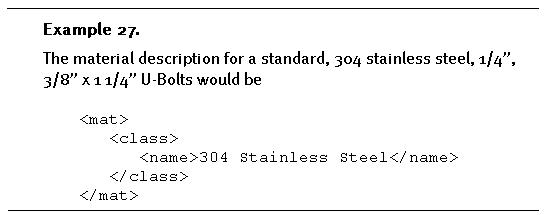
Common
materials or ingredients may have more than one
name. Acetylsalicylic acid, for example, is common
know as Aspirin®. Other types of names provide
additional information, such as more detailed
information on composition or the origin or manufacturer
of the material. Aluminum is a valid name for
a material, but 6061-T26 provides more specific
information on alloying and heat-treatment. Ibuprofen
is otherwise know as Advil®, Excedrin®,
Motrin®, Motirn® IB, Provel® or
Rufen®, and Nuprin® implies information
on manufacturer, dosage and intended use. Each
of these may be accomodated by a separate class
entry within the mat element.
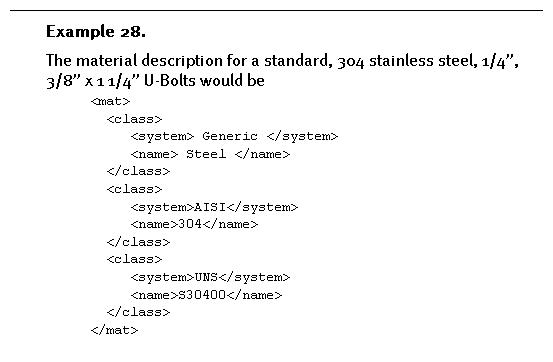
Codes
As
with many elements in PML, the material element
optional includes one or more code
elements. These may reference international, national,
local, industrial or corporate code numbers. The
code
element allows easy access to standard databases,
compliance standards and legacy numbering systems.
The
code element includes an optional label attribute
indicating the type of code uses. Product codes,
Material Safety Data Sheet (MSDS) numbers, federal
regulatory codes, CAS Registry Number are all
examples of material codes.
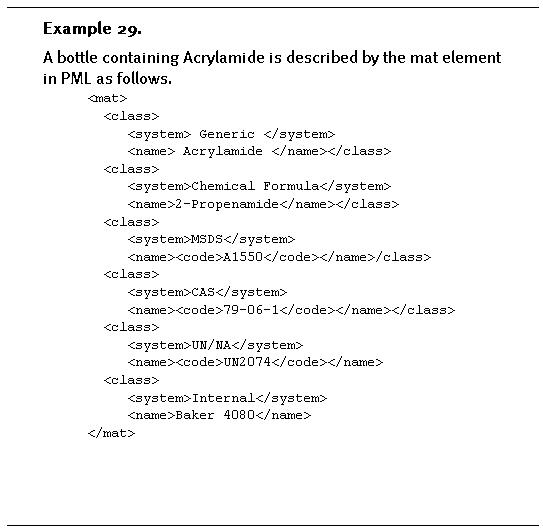
The
names and codes serve primarily to reference additional
information about the material. These are used
by companies, shippers, regulators and emergency
workers to access additional information on handling,
storage, transport and disposal. While these codes
are necessary for current classification and label
requirements, they may be eventually augmented
- or even replace - by the virtual Electronic
Product Code.
Virtual
EPC
As
discussed in the previous chapter, each
class element allows an optional
epc element. This Electronic Product Code
is "virtual," in that it is not encoded
on a physical tag, but serves as a reference to
on-line information using the same networking
infrastructure. In other words, this virtual EPC
code uses the ONS to look-up information in a
PML file about the material class.
The
fields in the virtual EPC code used here have
a somewhat difference interpretation. The "product
code" or "class" refers to the
catalog, and the serial number to the "entry"
into that catalog. The MSDS catalog, for example,
may be assigned the number 0001AD2 and the serial
number for Acrylamide the entry 00002D1E.
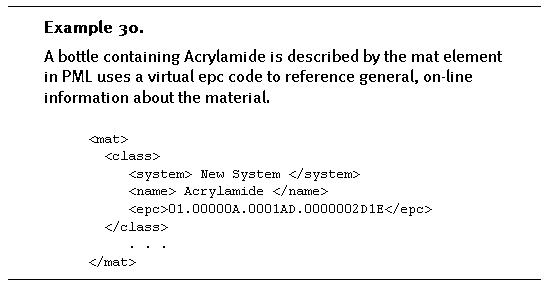
The
advantage of the virtual EPC code is that all
the material names, properties, safety information,
etc. are referenced to a common, standard source
without having to replicate information indefinitely
within distributed PML files. In addition, more
exhaustive descriptions are be afforded than is
possible within a specific object PML file, given
size and bandwidth requirements.
Composition
Most
materials are not pure. Metals are alloyed, chemicals
are mixed, foods are processed and liquids are
blended. In order to describe admixture, the mat
element allows one or more mat
elements. These may represent, for example, an
ingredient list for foods or alloying for metals.
Each
mat
element also provides an optional comp
attribute, used to describe the nature of the
composition. The composition may be an "aggregate",
"mixture", "alloy", "compound"
or any other description of composition.
<mat comp=
string
>
<mat>. . .</mat>
<mat comp= string
>
<mat> . . . </mat>
<mat> . . . </mat>
<mat> . . . </mat>
. . .
</mat>
. . .
</mat>
Quantity
The
compound list as given above describes the types
of materials that make up a composition, but not
the amounts. Therefore each mat
element includes an optional msr
(or measurement) element indicating the amount,
quantity or percentage of the material. The msr
element is described in detail in Chapter 5.
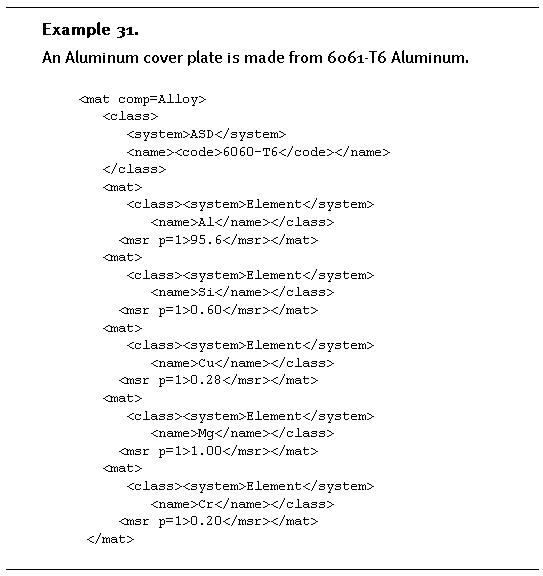
This
example is for illustration. It is likely this
type of information would reside in a common or
central repository and be reference via its virtual
EPC number.
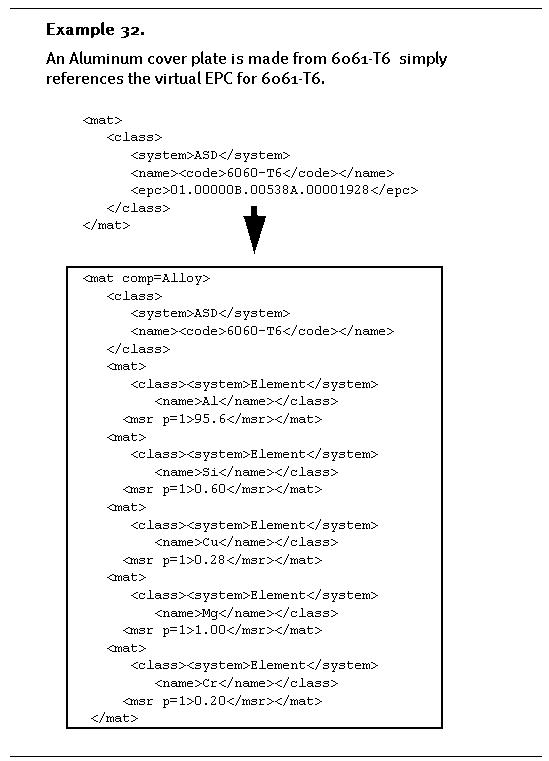
Type
Finally,
we can use the mat
element to describe different material aspects
of the physical object. For example, we may just
want to list the nutritional information or perhaps
the fat content of food. We may be required to
list only the hazardous materials in a product.
Thus one ore more mat
elements are allowed within the description of
a single object. Each distinguished using a different
label
attribute.
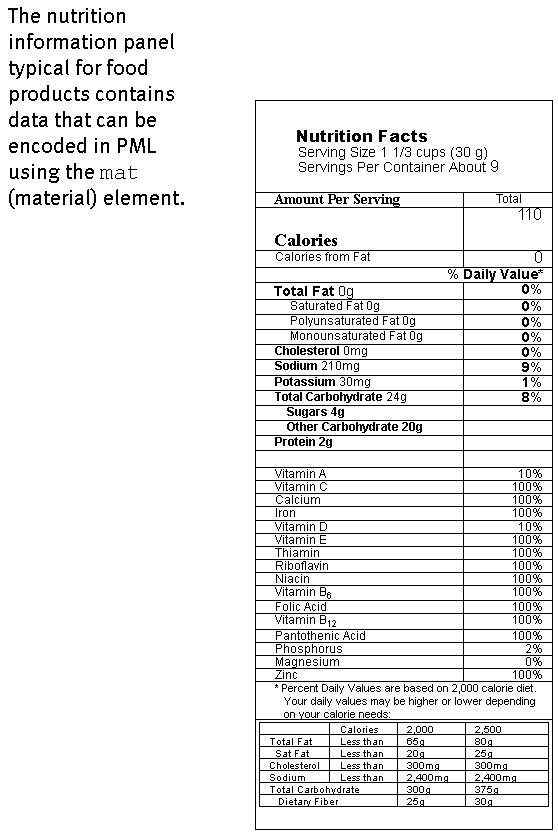
<mat
label= "nutrition" comp= "composition">
<mat><class><system> USFDA </system>
<name> Vitamin A </name></class>
<mat><class><system> USFDA </system>
<name> Vitamin C </name></class>
<mat><class><system> Element
</system>
<name> Calcium </name></class>
<mat><class><system> Element
</system>
<name> Iron </name></class>
<mat><class><system> USFDA </system>
<name> Vitamin D </name></class>
<mat><class><system> USFDA </system>
<name> Vitamin E </name></class>
<mat><class><system> USFDA </system>
<name> Thiamin </name></class>
<mat><class><system> USFDA </system>
<name>
Riboflavin </name></class>
<mat><class><system> USFDA </system>
<name> Niacin </name></class>
<mat><class><system> USFDA </system>
<name> Vitamin B6 </name></class>
<mat><class><system> USFDA </system>
<name> Folic Acid </name></class>
<mat><class><system> USFDA </system>
<name> Vitamin B12 </name></class>
<mat><class><system> USFDA </system>
<name> Pantothenic Acid </name></class>
<mat><class><system> Element
</system>
<name> Phosphorus </name></class>
<mat><class><system> Element
</system>
<name> Magnesium </name></class>
<mat><class><system> Element
</system>
<name> Zinc </name></class>
Form
The
Physical Markup Language provides a general description
of the physical form of objects. This information
is intended for general planning, such as for packing
and shipping, as well as inventory management and
storage.
There
are many standards and formats for describing the
physical shape of objects. Many of these come for
applications in computer aided design (CAD), mechanical
engineering, digital animation and computer games.
While
previous standards for solid modeling provide some
guidance in the development of the PML, the applications
differ. Most solid modeling specifications are focused
on the appearance of the object rendered on the
computer screen. Others are intended for the engineering
design, manufacturing and mechanical assembly.
The
Physical Markup Language, on the other hand, is
directed toward general object descriptions for
industrial, commercial and consumer applications.
In this sense, the structural definition must cover
a wider range of objects - not just polyhedral solids
- yet does not necessitate the complexity and detail
of standard solid modelers.
Physical
objects described by PML may include solids, liquids
and gases. Even among solid objects, PML may need
to describe flexible linear
objects such as string, ropes, wires and cables,
flexible planar objects
such as cloth, paper, sheets and rubber, or
compliant solid objects, such as sponges and
cushions.
The
following sections outline the components of the
structure definition. These include (1) a bounding
volume definition useful for planning, storage,
shipping and transportation, (2) a geometry specification
allows more detailed physical descriptions - particularly
for objects not easily described by a simple volume
and (3) general descriptive elements of overall
physical characteristics - such as shipping weight,
total volume, etc.
Bounding
Volume
Often
it is helpful to know the approximate volume of
an object. This may be useful for general planning,
packaging, storage and transportation. We define
a bound
element that allow optional box
, cylinder
or sphere
elements.
As
evident from their names, the box
, cylinder
or sphere
elements imply a circumscribing volume around
the object of a box, cylinder or sphere.
The
specification for the box
element is straight forward. The element contains
three numbers separated by white space representing
the height, width and depth of a rectangular solid.
In accordance with the Physical Markup Language
specification the dimensions are all measured
in meters.
<bound>
<box> height width depth
</box>
</bound>
The
cylinder is represented by a
height and diameter.
<bound>
<cylinder> height diameter
</cylinder>
</bound>
The
sphere is simply represented
by diameter.
<bound>
<sphere> diameter
</sphere>
</bound>
In
order to specify tolerance and accuracy, the bound
element also allows msr elements.
<bound>
<box>
<msr> height </msr>
<msr> width </msr>
<msr> depth </msr>
</box>
</bound>
<bound>
<cylinder>
<msr> height </msr>
<msr> diameter </msr>
</cylinder>
</bound>
<bound>
<sphere>
<msr> diameter </msr>
</sphere>
</bound>
Geometry
Beyond
bounding volumes, PML allows more complex geometric
descriptions, included the linear, planar and solid
objects. In particular, the geo
element describes extruded objects, thin planar
objects and general solids.
Extrusions
We
define an extrude
element for circular, tubular or general extruded
shapes. The extrude element
includes a type
attribute that accepts three values:
"round" , "tube"
and "shape" .
If
the attribute type
is set to "round"
the extrude
element expects two floating point numbers (separated
by white space) and interprets these as length
and diameter.
Again
the measurement definition is premitted to define
accuracy and tolerances.
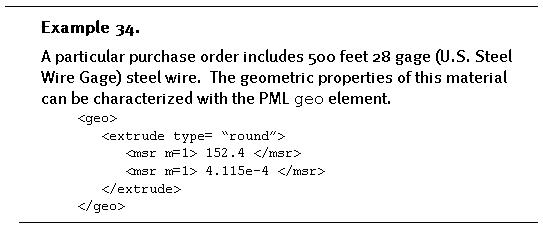
If
the type
attribute is set to "tube"
the extruded profile is annular and the
extrude
element accepts three numbers length, inner and
outer diameters. Again both three numbers separated
by white space or three measurement elements are
accepted.
length inner-diameter outer-diameter
<msr> inner-diameter
</msr>
<msr> outer-diameter
</msr>
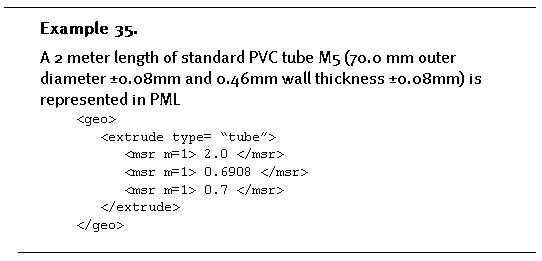
Finally,
if the type
attribute is set to "shape"
the extruded profile is defined by a length and
an arbitrary polygon. We include an array
element (previously defined) that accepts an array
of spatial points, which define the extruded cross
section.
The
points are separated from one another with a comma
",". Each two dimensional point is defined
by two floating point numbers separated by white
space.
Sheets
Planar
shapes such as plastic sheets and cloth are defined
using the same method as extruded profiles. Simply
the length (that is the "thickness")
is small relative to the size of the profile.
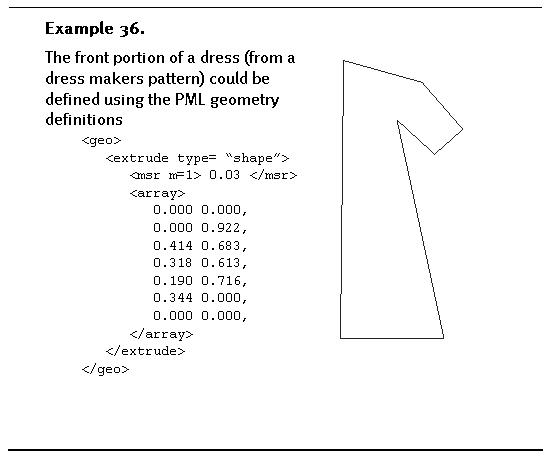
Solids
Of
the many ways to define a three dimensional solid,
this version of PML defines a simple specification.
The geo
element accepts a shape
element that contains an array of vertices, defined
by the array
element, and an array of indices, defined by the
index
element. The shape
element is thus an indexed array of polygons that
form an arbitrary polyhedron.
General
Often
the exact shape and material of an object is not
known, but the overall physical properties are,
such as the weight and volume. Often these are further
classified based on packaging. So that we may specifications
for gross weight, net weight, shipping weight, etc.
PML
allows an easy mechanism to record these and other
general characteristics using the msr
element previously described. Therefore the physical
properties specification allows one or more msr
elements, which can describe any overall physical
characteristic such as net weight and shipping volume.
<msr
label= "physical property"
> value </msr>
<msr label=" physical
property "> value </msr>
. . .
<msr label=" physical
property "> value </msr>
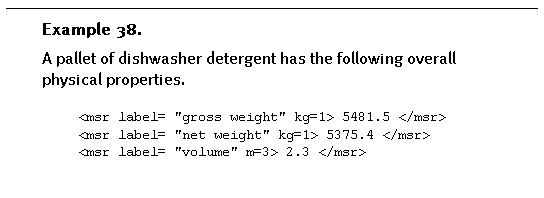
Specification:
Physical Properties
<mat label= string
comp= string >
<mat><msr> . . . </msr></mat>
<mat><msr> . . . </msr></mat>
<box> height width depth
</box>
<cylinder> height diameter
</cylinder>
<sphere> diameter
</sphere>
<extrude type="round">
length diameter </extrude>
length inner-diameter outer-diameterr
</extrude>
|
|
|
| |
|
|
 |
 |
|
|

